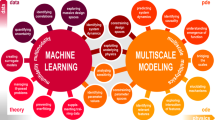Abstract
Mathematical simulations are of increasing relevance for applications in engineering and the life sciences. Disciplines like epidemiology, biomechanics, medical image processing, just to name a few, are subject of academic research since decades. With modern numerical methods and the advent of increasing computing power not just simulations of biological systems are within reach, but also questions of optimizing the systems to aim at a certain goal can be addressed. In this paper, we will discuss some examples from epidemiology as well as biomechanical models for muscles. All these models are based on a set of differential equations. Defining a suitable cost functional to measure the distance to the goal of our optimization, mathematical tools from constrained optimization can be applied to solve optimization problems and to derive suitable numerical algorithms.








Similar content being viewed by others
References
Tröltzsch, F.: Optimale Steuerung partieller Differentialgleichungen, 311 pp. Vieweg + Teubner, Wiesbaden (2009)
Aldila, D., Götz, T., Soewono, E.: An optimal control problem arising from a dengue disease transmission model. Math. Biosci. 242(1), 9–16 (2013)
Wijaya, K.P., Götz, T., Soewono, E.: An optimal control model of mosquito reduction management in a dengue endemic region. Int. J. Biomath. 7(5), 1450,056 (2014). doi:10.1142/S1793524514500569
Rockenfeller, R., Goetz, T.: Optimal control of isometric muscle dynamics. J. Math. Fundam. Sci. 47(1), 12–30 (2015). doi:10.5614/j.math.fund.sci.2015.47.1.2
Hinze, M., Pinnau, R., Ulbrich, S.: Optimization with PDE Cconstraints, Mathematical Modelling: Theory and Application, vol. 23. Springer-Verlag, New York (2009)
Bailey, N.: The mathematical theory of infectious diseases and its applications, 2nd Edition. Charles Griffin & Company Ltd (1975)
Dietz, K.: Transmission and control of arbovirus diseases. In: Ludwig, D., Cooke, K.L. (eds.) Epidemiology, pp. 104–121. SIAM, Philadelphia (1975)
Wijaya, K.P., Götz, T., Soewono, E.: Advances in mosquito dynamics modeling. Arxiv 1503, 02573 (2015)
Bauer, S., Gruber, K., Kilian, F.: 3d-computermodell der menschlichen lendenwirbelsäule—entwicklung und anwendungsmöglichkeiten in der medizin. Biomedizinische Technik, Gemeinsame Jahrestagung der Deutschen. Österreichi. de Gruyter, Rostock (2010)
Grujicic, M., Pandurangan, B., Xie, X., Gramopadhye, A., Wagner, D., Ozen, M.: Musculoskeletal computational analysis of the influence of car-seat design/adjustments on long-distance driving fatigue. Int. J. Ind. Ergon. 40(3), 345–355 (2010). doi:10.1016/j.ergon.2010.01.002 http://www.sciencedirect.com/science/article/pii/S016981411000003X
Seyfarth, A., Grimmer, S., Häufle, D.F.B., Kalveram, K.T.: Can robots help to understand human locomotion? Automatisierungstechnik 60(11), 653–661 (2012). URL http://dblp.uni-trier.de/db/journals/at/at60.htmlSeyfarthGHK12
Keppler, V.: Biomechanische modellbildung zur simulation zweier mensch-maschinen-schnittstellen. Ph.D. thesis, Eberhard-Karls-Universität zu Tübingen, Fakultät für Mathematik und Physik (2003)
Hill, A.V.: The heat of shortening and the dynamic constants of muscle. Proc. R. Soc. Lond. B 126, 136–195 (1938)
Günther, M., Schmitt, S., Wank, V.: High-frequency oscillations as a consequence of neglected serial damping in Hill-type muscle models. Biol. Cybern. 1(97), 63–79 (2007)
Haeufle, D., Günther, M., Bayer, A., Schmitt, S.: Hill-type muscle model with serial damping and eccentric force–velocity relation. J. Biomech. 47(6), 1531–1536 (2014)
Hatze, H.: A myocybernetic control model of skeletal muscle. Biol. Cybern. 25(2), 103–119 (1977)
Wank, V.: Muscle growth and fiber type composition in hind limb muscles during postnatal development in pigs. Cells Tissues Organs 182, 171–181 (2006)
Hawkins, D., Hull, M.L.: Muscle forces as affected by fatigue: mathematical model and experimental verification. J. Biomech. 26(9), 1117–1128 (1993)
Zajac, F.E.: Muscle and tendon: properties, models, scaling, and application to biomechanics and motor control. Crit. Rev. Biomed. Eng. 17(4), 359–411 (1989)
Acknowledgments
Karunia Putra Wijaya has been financially supported by Indonesia Endowment Fund for Education (LPDP)
Author information
Authors and Affiliations
Corresponding author
Rights and permissions
About this article
Cite this article
Götz, T., Rockenfeller, R. & Wijaya, K.P. Optimization problems in epidemiology, biomechanics & medicine. Int J Adv Eng Sci Appl Math 7, 25–32 (2015). https://doi.org/10.1007/s12572-015-0130-5
Published:
Issue Date:
DOI: https://doi.org/10.1007/s12572-015-0130-5



